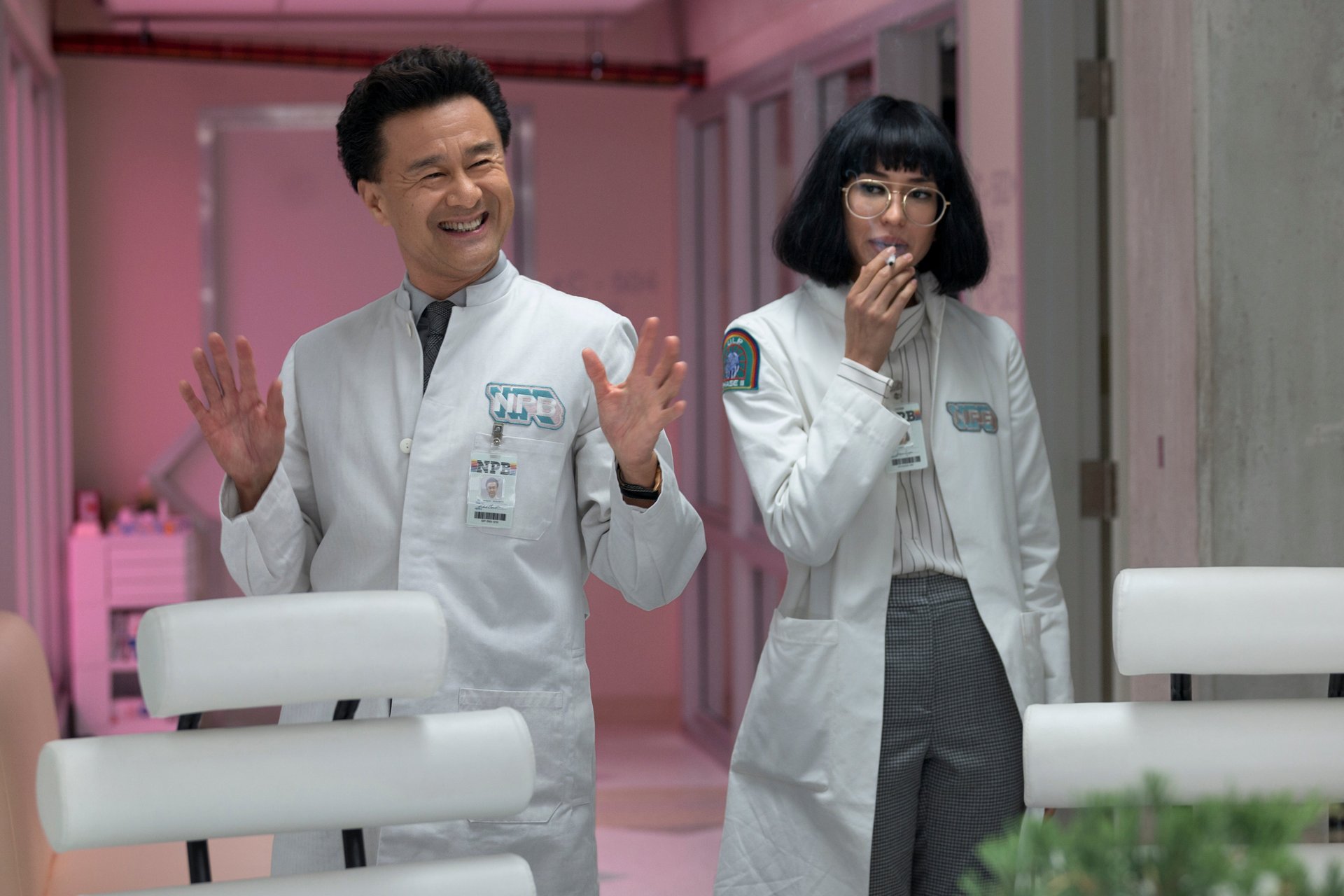Nothing about Netflix’s “Maniac” is normal. That’s why it’s so damn good
In one episode late in Netflix’s latest TV series, movie star Emma Stone plays a drunken Elven ranger. In the next episode, movie star Jonah Hill plays a gimlet-drinking dunce named “Snorri” who refers to himself in the third person in a bad Icelandic accent.


In one episode late in Netflix’s latest TV series, movie star Emma Stone plays a drunken Elven ranger. In the next episode, movie star Jonah Hill plays a gimlet-drinking dunce named “Snorri” who refers to himself in the third person in a bad Icelandic accent.
This will all make more sense when you watch Maniac. Sort of.
The Netflix miniseries, out today (Sept. 21), takes much of what you have learned to expect from TV and launches it into the ether. Episode lengths fluctuate wildly between about 25 and 45 minutes. The genre veers from sci-fi to dark comedy to family drama, but it wouldn’t be accurate to call it just one, or even two, of these.
Directed by the recently anointed James Bond filmmaker Cary Fukunaga and written by The Leftovers scribe Patrick Somerville, Maniac is a new kind of TV experience that constantly questions what it means to be “normal,” or if such a thing even exists.
Stone and Hill are Annie and Owen, two subjects in a mysterious pharmaceutical trial under the direction of one Dr. James K. Mantleray, played by Justin Theroux. Mantleray’s thesis is at once simple and crazy: Each subject ingests a series of psychedelic pills that induce wild fantasies (or are they delusions?) which he believes will allow them to eliminate their individual traumas and neuroses. Humanity can “evolve past suffering,” Mantleray states. Many of the episodes follow Annie and Owen through these fantasies, which get more bizarre as the trial goes on.
Annie is there for a fix: She’s become dependent on the first pill in the trial, so she cons her way into the study in order to get more drugs. Owen, the black sheep of a wealthy New York family, signs up for the cash (he rejects his family’s offers for financial assistance), or maybe he’s doing it because he actually thinks it could help him. Owen very well may be schizophrenic. He’s come to terms with the fact that some of the things he sees are not real, and has nearly given up trying to tell the difference.
The whole experiment is monitored by an artificial intelligence supercomputer called GRTA that’s modeled after Mantleray’s celebrity psychologist mother, Dr. Greta Mantleray. (Sally Field plays Greta and voices the AI). GRTA, nicknamed, Gertie, is an even more unstable version of HAL from 2001: A Space Odyssey.
You see, nothing in Maniac behaves exactly as it should. That’s the point. “We want to interrogate the idea of normalcy,” Somerville told Quartz.
That interrogation is baked deep into the show’s DNA. The default human setting is dysfunction, Maniac argues. No one is normal. “Normal” doesn’t exist. We don’t need to be cured of our abnormalities so much as find some peace with them, and then figure out how to move forward.
Maniac is surprisingly as positive and poignant as it is trippy. Where many dense shows like this have eschewed emotions in favor of the next twist to unravel or mystery to solve, Maniac is the rare psychological “puzzle show” that wears its heart on its sleeve, finding humanity in psychological mystery. Internet sleuths will be tempted to scrutinize the many intricacies of the show, though they should resist that urge. The takeaway for viewers of Maniac is quite ordinary, but profound: life is about making connections.
It’s strange to see a show like this have such a clear, optimistic point of view. Again, this is not normal.
Even the way the show came together was not normal. Fukunaga and producer Anonymous Content owned the rights to the story, based (very, very loosely) on a Norwegian series of the same name. They brought Stone and Hill on board and then sold the show to Netflix, “without a take,” Somerville explained. That means there was no actual show at that point—just a vague idea of one, with two huge movie stars and an acclaimed auteur director (Fukunaga directed Beasts of No Nation and the first season of True Detective) attached. Somerville came on board and started to hash out the story specifics with Fukunaga in pretty much the opposite order of how most TV shows are conceived.
If what the pair came up with is weird, then there’s a version of it out there somewhere that’s even weirder: Fukunaga and Somerville recounted how several fleshed-out ideas—including full scripts—were thrown out mid-development for various reasons. Some of the fantasies and delusions they cooked up were apparently just too meta and incomprehensible.
But what we do get is crazy enough on its own. The show takes place in a meticulously rendered and utterly bizzaro version of New York City. It’s “the future through a 1980s filter,” says Billy Magnussen, who is excellent as always as Owen’s waspy, asshole brother, on trial for assault. And that’s as good a description as any: All of the technology, fashion, and architecture in the show is straight out of that decade, even as it’s clear we’re supposed to be at some point in the future. (Mantleray says at one point that he was born in 1977, which would put the series in the 2020s if he’s roughly the same age as the actor that plays him—though the exact date doesn’t really matter.)
The setting spawns some of Maniac‘s coolest—and funniest—details. The Statue of Liberty has been replaced by the “Statue of Extra Liberty,” a ridiculous act of one-upmanship that may or may not be a subtle dig at the current president of the United States. The city runs on a funhouse-mirror gig economy: One company called “Friend Proxy” sends out humans to role-play as real friends of its users. Another called “Ad Buddy” allows users to acquire products and services for free if they listen to someone literally yell advertisements at them. Best of all, there are what can only be described as poop bots—pint-sized drones that scour the streets for garbage.

Maniac is a show with its tongue firmly in its cheek. It may not be a “comedy” in the classic sense, but it’s completely hilarious. Everyone in the cast looks like they’re having a total blast, but the star of the show, humor-wise, is Theroux, whose nervous and insecure but self-important Mantleray quickly vaults into the upper echelon of TV’s all-time great comedic characters. (The way we are formally introduced to Dr. Mantleray in the flesh is simply remarkable—don’t let anyone spoil that moment for you.)
For all the technobabble included in the show, absolutely none of it needs to be taken seriously. Theroux’s line readings of “The last thing we want is a data taint,” and “Globular cluster of arborized realities” are as funny as they sound, and there’s a lot more where they came from.
Somerville and Fukunaga both repeatedly stressed that the series is super collaborative. “We incorporated so many different elements from so many different people,” Somerville said. Indeed, Maniac is the kind of show that can only happen after late-night brainstorms and half-baked group pitches. Of course, that sometimes results in messy storytelling, and some ideas in the show are clearly executed better than others. (One of the drug-induced fantasies is a bore, while Annie’s story line on the whole is stronger than Owen’s.)
The show owes debts to Inception for its mind-infiltrating dream sequences; to 2001 for the AI-gone-rogue elements; to Brazil for the quasi-dystopian setting; and to Eternal Sunshine of the Spotless Mind for the argument that love and human connection are forces we don’t truly understand—and that they can arguably transcend modern science. (Hey, wait, Interstellar explored that too.)
Maniac is very much a Netflix show in this way—you can almost see the algorithm at work, how it guided Fukunaga and company to formulate a show that would appeal to fans of various shows and films. But however much it was or wasn’t influenced by past work, the result is, strangely, wholly unique. The ingredients are mostly familiar; the cocktail is something new. There’s absolutely nothing quite like Maniac.
“TV now is sort of about avoiding clichés,” Theroux told Quartz. Theroux knows something about avoiding clichés, as the star of HBO’s beautifully original series The Leftovers—and Maniac carries some of that off-kilter DNA. It’s a genreless, amorphous, stunningly abnormal piece of filmmaking that tells us it’s okay not to be a cliché. And it’s even better to be a maniac.